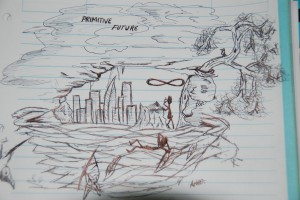
Relationship between Sou Fujimoto´s Primitive Future and all other readings
In these writing Sou Fujimoto expresses in 20 different main themes his idea of a Primitive Future in architecture. From it we can understand the global relationship between creating spaces from new or existing ones in order to achieve a suitable place for the user.
Fujimoto compares the difference between a nest and a cave, the nest is a tailor made space which suits perfectly to all the necessities of the user, and the cave is an unknown space which has de quality of transformation and creation of infinite connections and uses, depending on who interacts with the space.
He also uses gradation as a keyword for future architecture and it explains the infinite amount of possibilities that the architect has at the designing stage of the project, by creating harmonic connections between a disordered environment, which actually works for a certain function in a precise time.
Primitive architecture encompasses the big scale with the smaller, the public with the private, and the city from the house. When he says in a metaphorical way that architecture should be like a forest, he refers to its property to create connections between the trees and the branches, the shadows and the sunlight, the inner spaces with the outside., the capacity that the architect needs to develop to find the middle point in a design in which he has an immense range of possibilities to create a nest out of a cave is actually the perfect idea of architecture itself, a hazy area in which everything merges.
The relationship with all of the texts discussed relays in the six basic relations in advanced architecture, which somehow help us architects to explain how the artificial, natural or virtual environments in our designs go throw time and space coexisting with the city, the house the garden, the idea, etc.
Doubts that came out after analyzing this text
When does the architect should stop the design and leave the user create his own connections within their new “cave”?
Is every “cave” in an in-between “ideal architecture” for the architect to explore and design or it can only be reached with the help of the user?
Personal research Topic
When should the architect stop his design and let the users create their own connections?
After reading and understanding the main ideas of Sou Fujimoto´s text, I started to question to myself which is the midpoint, the watershed in the architects design roll. As we understand the connections that we can design depend on the necessities and likes of the future users of the space, trying to use the space in a more efficient way, depending on its function, environment and purpose. But also after we deliver the project, the user starts to create new connections transforming their “cave” into a “nest”, and that’s the key point of the research.
So new questions appear, should the architect work hand by hand with the user during the entire project, or should we let the user be the designer of its own cave so that we can help perfecting their nest? But then if the correct answer is the second one, we would only be a tool to reach the idea of a perfect architecture in our own-user designs.
